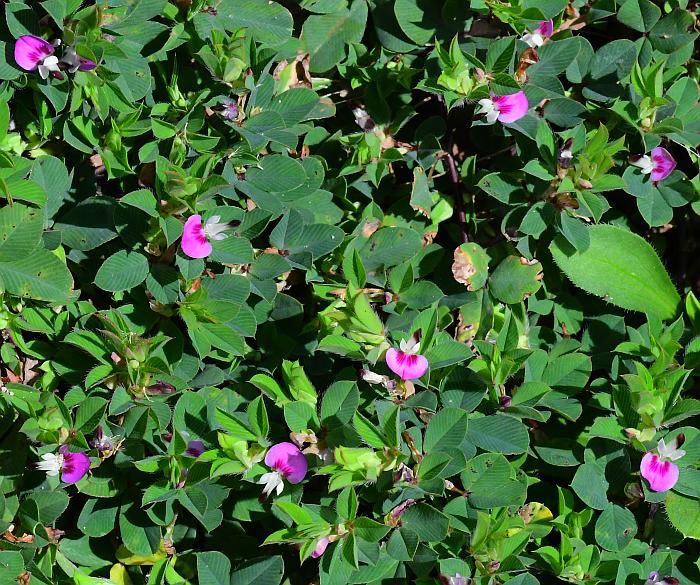Kummerowia stipulacea (Maxim.) Makino
Korean Clover, Korean Lespedeza

Introduced
CC = *
CW = 3
MOC = 69
© SRTurner
Kummerowia stipulacea (Maxim.) MakinoKorean Clover, Korean Lespedeza | |
 |
Introduced CC = * CW = 3 MOC = 69 |
© SRTurner |
|
Family - Fabaceae/Faboideae Habit - Annual forb with fibrous roots.
Stems - Spreading, sometimes ascending or with erect tips, often mat-forming, to 60 cm, sometimes multiple from base, branching, pubescent with stiff, forward-pointing, often appressed hairs (sometimes only in lines from beneath leaf petiole).
Leaves - Alternate, petiolate, stipulate, trifoliate. Lower and median leaves with petioles 4-10 mm long, these sparsely to moderately pubescent with forward-pointing hairs. Stipules of lower and median leaves 4-8 mm long, conspicuous, striate-nerved, straw-colored and papery at maturity. Leaflets 5-25 mm long, obovate to spatulate, tapered or narrowed at the base, rounded to shallowly notched at the tip, the venation distinctively herringboned, the upper surface glabrous, the undersurface glabrous or more commonly pubescent along the midvein, the margins with conspicuous, spreading, somewhat curved hairs.
Inflorescence - Axillary flowers in crowded lateral branches. Pedicels 1-1.5mm long, green, with a few cilia or not. Calyx subtended by 3 minute bracts. Bracts ovate, greenish-white, entire, 1mm long, .6mm broad.
Flowers - Calyces 5-lobed but appearing 4-lobed due to fusion of upper 2 sepals, 1.6-2.2 mm long (slightly shorter in cleistogamous flowers), the tube about as long as the lobes, glabrous or sparsely hairy along the margins, at maturity covering 1/3-1/2 of the fruit. Corollas papilionaceous, 6-7 mm long (shorter in cleistogamous flowers), pink-purple, with large white patches at the base of the banner, the keel longer than the wings. Stamens 10, 9 of these with the filaments fused together most of their length, the remaining filament free, the anthers all of similar size.
Fruits - Modified legumes, 2.5-3.2 mm long, flattened, obovate to elliptic in outline, rounded to bluntly or broadly pointed at the tip, single-seeded, the surfaces with a conspicuous network of nerves.
Flowering - July - October. Habitat - Glades, rocky areas in upland prairies, forest openings, pastures, fields, roadsides, railroads, disturbed open places. Origin - Native to Asia. Lookalikes - K. striata. Other info. - This little species can be found throughout Missouri. Its wider range in the U.S. comprises a broad horizontal band extending from Kansas to the Atlantic Coast. It is recognized by its prostrate growth habit and small flowers with a distinctive purple and white pattern. It closely resembles K. striata, except for having antrorse rather than retrorse hairs along the stem, and leaflets with conspicuous ciliate hairs. It is highly disturbance adapted and tolerant of drought, poor soils, and mowing. It can thrive in lawns, sometimes becoming the main herbaceous content. The plant was deliberately introduced in the U.S. in 1919 as a forage crop. Like many others in this category, it is nutritious to livestock, and the small fruits provide a food source for wildlife, but the plant rapidly escaped and spread aggressively throughout the state. A synonym for the species is Lespedeza stipulacea Maxim. Photographs taken in Brown Summit, NC., 8-24-02 (DETenaglia); also at Crowley's Ridge Conservation Area, Stoddard County, MO, 8-14-2009, Don Robinson State Park, Jefferson County, MO, 9-2-2021, and near Labadie, Franklin County, MO, 9-7-2021 and 9-3-2022 (SRTurner). |